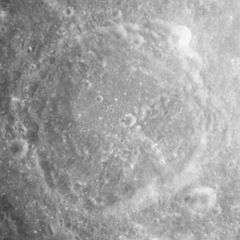Einthoven (crater)
|
Einthoven from Apollo 17 | |
| Coordinates | 4°54′S 109°36′E / 4.9°S 109.6°ECoordinates: 4°54′S 109°36′E / 4.9°S 109.6°E |
|---|---|
| Diameter | 69 km |
| Depth | Unknown |
| Colongitude | 251° at sunrise |
| Eponym | Willem Einthoven |

Einthoven is a lunar impact crater that is located on the far side of the Moon. It is located beyond the region of the surface that is sometimes brought into view due to libration, and so can not be viewed from the Earth. Einthoven is located to the northeast of the huge walled plain Pasteur.
This is a circular crater with some minor terrace structure along the inner rim. The satellite crater Einthoven X is attached to the northwestern rim, and is partly overlaid by Einthoven. The hummocky interior floor is marked only by a small crater in the eastern half and a few tiny craterlets.
Prior to naming, Einthoven was called Crater 273 by the IAU.[1]
Satellite craters
By convention these features are identified on lunar maps by placing the letter on the side of the crater midpoint that is closest to Einthoven.
| Einthoven | Latitude | Longitude | Diameter |
|---|---|---|---|
| G | 5.3° S | 111.8° E | 34 km |
| K | 7.9° S | 111.2° E | 21 km |
| L | 8.0° S | 110.7° E | 16 km |
| M | 7.5° S | 109.6° E | 52 km |
| P | 6.8° S | 108.5° E | 18 km |
| R | 5.9° S | 107.0° E | 13 km |
| X | 3.6° S | 108.7° E | 45 km |
References
- ↑ Lunar Landmark Locations - Apollo 8, 10, 11, and 12 Missions. NASA technical note D-6082. Manned Spacecraft Center, Houston, Texas. November 1970. Figure 20.
- Andersson, L. E.; Whitaker, E. A. (1982). NASA Catalogue of Lunar Nomenclature. NASA RP-1097.
- Blue, Jennifer (July 25, 2007). "Gazetteer of Planetary Nomenclature". USGS. Retrieved 2007-08-05.
- Bussey, B.; Spudis, P. (2004). The Clementine Atlas of the Moon. New York: Cambridge University Press. ISBN 978-0-521-81528-4.
- Cocks, Elijah E.; Cocks, Josiah C. (1995). Who's Who on the Moon: A Biographical Dictionary of Lunar Nomenclature. Tudor Publishers. ISBN 978-0-936389-27-1.
- McDowell, Jonathan (July 15, 2007). "Lunar Nomenclature". Jonathan's Space Report. Retrieved 2007-10-24.
- Menzel, D. H.; Minnaert, M.; Levin, B.; Dollfus, A.; Bell, B. (1971). "Report on Lunar Nomenclature by the Working Group of Commission 17 of the IAU". Space Science Reviews. 12 (2): 136–186. Bibcode:1971SSRv...12..136M. doi:10.1007/BF00171763.
- Moore, Patrick (2001). On the Moon. Sterling Publishing Co. ISBN 978-0-304-35469-6.
- Price, Fred W. (1988). The Moon Observer's Handbook. Cambridge University Press. ISBN 978-0-521-33500-3.
- Rükl, Antonín (1990). Atlas of the Moon. Kalmbach Books. ISBN 978-0-913135-17-4.
- Webb, Rev. T. W. (1962). Celestial Objects for Common Telescopes (6th revised ed.). Dover. ISBN 978-0-486-20917-3.
- Whitaker, Ewen A. (1999). Mapping and Naming the Moon. Cambridge University Press. ISBN 978-0-521-62248-6.
- Wlasuk, Peter T. (2000). Observing the Moon. Springer. ISBN 978-1-85233-193-1.
